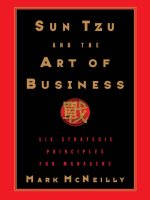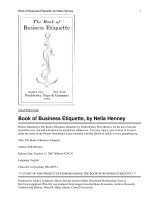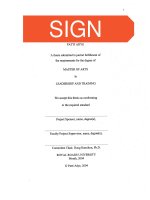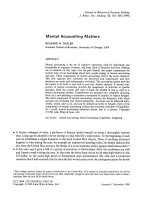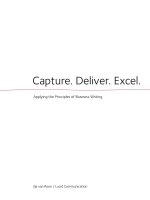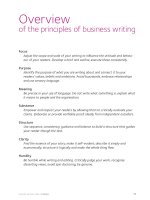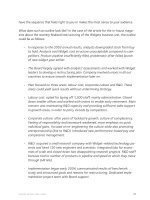Managerial accounting the cornerstone of business decision making hansen
Bạn đang xem bản rút gọn của tài liệu. Xem và tải ngay bản đầy đủ của tài liệu tại đây (19.8 MB, 946 trang )
www.ebookslides.com
Copyright 2018 Cengage Learning. All Rights Reserved. May not be copied, scanned, or duplicated, in whole or in part. WCN 02-200-203
www.ebookslides.com
SEVENTH EDITION
Managerial Accounting
THE C O RNERSTO N E O F
B U SIN E SS DECI SI O N MA KI NG
Maryanne M. Mowen
Oklahoma State University
Don R. Hansen
Oklahoma State University
Dan L. Heitger
Miami University
Australia • Brazil • Mexico • Singapore • United Kingdom • United States
Copyright 2018 Cengage Learning. All Rights Reserved. May not be copied, scanned, or duplicated, in whole or in part. WCN 02-200-203
www.ebookslides.com
Managerial Accounting: The Cornerstone of Business
Decision Making, Seventh Edition
Maryanne M. Mowen, Don R. Hansen, Dan L. Heitger
Sr. Vice President, General Manager,
Social Science and Qualitative Business: Erin Joyner
© 2018, 2014 Cengage Learning®
ALL RIGHTS RESERVED. No part of this work covered by the copyright
herein may be reproduced or distributed in any form or by any means,
except as permitted by U.S. copyright law, without the prior written
permission of the copyright owner.
Executive Product Director: Mike Schenk
Product Director: Jason Fremder
Product Manager: Matt Filimonov
Content Development Manager: Daniel Celenza
Product Assistant: Audrey Jacobs
Executive Marketing Manager: Robin LeFevre
Sr. Content Project Manager: Martha Conway
Manufacturing Planner: Doug Wilke
For product information and technology assistance,
contact us at Cengage Learning
Customer & Sales Support, 1-800-354-9706
For permission to use material from this text or product,
submit all requests online at
www.cengage.com/permissions
Further permissions questions can be emailed to
Production Service: Cenveo
Sr. Art Director: Michelle Kunkler
Unless otherwise noted, all items are © Cengage Learning.
Cover and Internal Designer: Harasymczuk Design
Cover Image: © Digital Storm/Shutterstock.com
Kicker Icon: Courtesy of Kicker
Kicker Speaker Image: © dencg/Shutterstock.com
Intellectual Property Analyst: Brittani Morgan
Intellectual Property Project Manager: Reba Frederics
Microsoft Excel® is a registered trademark of Microsoft Corporation.
© 2017 Microsoft.
Library of Congress Control Number: 2016958236
ISBN: 978-1-337-11577-3
Cengage Learning
20 Channel Center Street
Boston, MA 02210
USA
Cengage Learning is a leading provider of customized learning solutions
with employees residing in nearly 40 different countries and sales in
more than 125 countries around the world. Find your local representative
at www.cengage.com.
Cengage Learning products are represented in Canada by
Nelson Education, Ltd.
To learn more about Cengage Learning Solutions, visit
www.cengage.com
Purchase any of our products at your local college store or at our
preferred online store www.cengagebrain.com
Printed in Canada
Print Number: 01
Print Year: 2016
Copyright 2018 Cengage Learning. All Rights Reserved. May not be copied, scanned, or duplicated, in whole or in part. WCN 02-200-203
www.ebookslides.com
This book is dedicated to our students—past, present, and future—
who are at the heart of our passion for teaching.
Copyright 2018 Cengage Learning. All Rights Reserved. May not be copied, scanned, or duplicated, in whole or in part. WCN 02-200-203
www.ebookslides.com
Brief Contents
CHAPTER 1
Introduction to Managerial Accounting
2
CHAPTER 2
Basic Managerial Accounting Concepts
30
CHAPTER 3
Cost Behavior and Forecasting
CHAPTER 4
Job-Order Costing and Overhead Application
CHAPTER 5
Activity-Based Costing and Management
CHAPTER 6
Process Costing
CHAPTER 7
Cost-Volume-Profit Analysis 332
MAKING
THE
78
148
214
276
CONNECTION 390
CHAPTER 8
Tactical Decision Making and Relevant Analysis
CHAPTER 9
Profit Planning and Flexible Budgets
CHAPTER 10
Standard Costing and Variance Analysis
MAKING
THE
CONNECTION
454
520
588
CHAPTER 11
Performance Evaluation and Decentralization
CHAPTER 12
Capital Investment Decisions
MAKING
THE
CONNECTION
697
Emerging Topics in Managerial Accounting
CHAPTER 14
Statement of Cash Flows
CHAPTER 15
Financial Statement Analysis
700
790
836
891
Check Figures
Index
590
644
CHAPTER 13
Glossary
392
899
903
iv
Copyright 2018 Cengage Learning. All Rights Reserved. May not be copied, scanned, or duplicated, in whole or in part. WCN 02-200-203
www.ebookslides.com
Dear Colleague,
We have been teaching managerial accounting for decades. We love it and believe strongly that
managerial accounting is one of the most important courses in the business curriculum! Since it
is one of the first business courses students take, we work to share our love and enthusiasm for the
material and to show each student that managerial accounting is both FUN and RELATABLE
to their current life, as well as to their future.
We wrote this book because there was no other book available that helped us reach the wide variety
of students we see each term. Reaching students is a challenge because:
• There is so much material to teach that instructors don’t have time for the “fun stuff;”
• Students don’t connect the detail with the big picture;
• Many students juggle jobs, family, and so on, so they have little time—their time in the class
must be optimized for understanding;
• Managerial accounting is not as straightforward as financial, and students must develop
judgment skills in addition to absorbing material;
• There is a tremendous diversity of students (incoming skills, language, etc.); and
• There is no standard road map to teach the course (a.k.a., the balance sheet).
Our approach is to make the entire managerial accounting experience for instructors and
students timely, meaningful, fun, and relatable. This edition contains numerous new
features that achieve these goals in a way that positively sets our book apart from all other
managerial accounting books. For instance, our new chapter, “Emerging Topics in Managerial
Accounting,” addresses timeliness by covering cutting-edge topics. Our unique “Here’s How It’s Used”
pedagogy enables students to enjoy the process of developing a deeper understanding of
managerial accounting and its implications for themselves, as well as businesses. Our watchwords
are “Here’s How:”
1. Here’s How It’s Used Concept Clip Animations for many major topics portray the most
difficult concepts in a brief and fun animated cartoon. They present the information in
a logical, entertaining, and relatable way that pertains not only to businesses, but also to
students’ everyday lives.
2. Here’s How It’s Used Examples (formerly Cornerstones) throughout the text walk students
through the most important managerial accounting models and help them solve computations. Students say these examples really get them started on their homework and help
them understand the material before class. As a result, the Examples allow the instructor to
focus valuable class time on the “why,” and allow students to understand the big picture—
helping students see the relevance and importance of what they are learning.
3. Here’s Why It’s Important highlights for students the reason that key topics within each
chapter are important. This new feature significantly helps students better understand the
big picture of why managerial accounting is important.
4. Experience Managerial Accounting Videos focus on real companies, such as Coldstone
Creamery, Second City Comedy Club, and Boyne USA ski resorts, and the integrated
real-world examples of Kicker Speakers provide students with inside access into how management accounting is used to make real-world business decisions.
v
Copyright 2018 Cengage Learning. All Rights Reserved. May not be copied, scanned, or duplicated, in whole or in part. WCN 02-200-203
www.ebookslides.com
Using our text, you don’t need to spend as much valuable class time teaching “how,” you can
focus on “why.”
• Examples are built around how students work, summarizing key procedures to help students complete homework independently.
• Because students are able to complete homework independently, they do not bombard the
instructor with “How do I do this?” type questions.
Students who want to go farther can use:
• Blueprint Problems. We wrote these expressly to accompany this book and help students
expand their understanding.
• Blueprint Problems Using Excel. We wrote these to help develop students’ spreadsheet
skills. Students are required to develop their own Excel formulas to solve the problems.
• Analyzing Relationships. We developed these to help students use a graphical approach
to see exactly how changing one or more underlying variables affects a model. These allow
students to engage in sensitivity analysis and to consider the related analytical questions.
These help to foster analytical skills and to develop judgment and understanding.
Our goal is to improve student understanding and preparedness while allowing you to focus on
meaningful applications of managerial accounting to important real-world topics. We believe it
will work in your classroom and look forward to teaming up with you to improve your students’
success and make managerial accounting meaningful, fun, and relatable.
Sincerely,
Maryanne Mowen, Don Hansen, Dan Heitger
vi
Copyright 2018 Cengage Learning. All Rights Reserved. May not be copied, scanned, or duplicated, in whole or in part. WCN 02-200-203
www.ebookslides.com
Close the Gap
Between Homework and Exam Performance
with
CengageNOWv2.
We’ve talked with hundreds of accounting
instructors across the country and we are learning
that online homework systems have created a new
challenge in the accounting course.
learning the content, but rather memorizing their
CengageNOWv2 better prepares students for
the exam by providing an online homework
experience that is similar to
what students will experience on the
exam and in the real world.
way through the system.
Read on to see how CengageNOWv2 helps close this gap.
We are hearing that students perform well on the
homework but poorly on the exam, which leads
instructors to believe that students are not truly
Copyright 2018 Cengage Learning. All Rights Reserved. May not be copied, scanned, or duplicated, in whole or in part. WCN 02-200-203
www.ebookslides.com
Closing the gap, one step at a time.
Multi-Panel View
One of the biggest complaints students have about online homework is the scrolling, which prevents students from
seeing the big picture and understanding the accounting system. This new Multi-Panel View in CengageNOWv2 enables
students to see all the elements of a problem on one screen.
• Students make
connections and see
the tasks as connected
components in the
accounting process.
• Dramatically reduced
scrolling eliminates
student frustration.
Blank Sheet of
Paper Experience
Many students perform
well on homework but
struggle when it comes
to exams. Now, with the
new Blank Sheet of Paper
Experience, students must
problem-solve on their
own, just as they would if
taking a test on a blank
sheet of paper. This discourages overreliance on the system.
Copyright 2018 Cengage Learning. All Rights Reserved. May not be copied, scanned, or duplicated, in whole or in part. WCN 02-200-203
www.ebookslides.com
From Motivation to Mastery
MOTIVATION:
Engage students and better prepare them for class.
Concept Clips
Written by the authors, these clips provide
students with a deeper explanation into the
why and the how of managerial accounting
concepts.
Video: Tell Me More
Tell Me More lecture activities explain the core
concepts of the chapter through an engaging
auditory and visual presentation that is ideal for
all class formats—flipped mode, online, hybrid,
face-to-face.
Adaptive Study Plan
The Adaptive Study Plan is an assignable/gradable study center that adapts
to each student’s unique needs and provides a remediation pathway to keep
students progressing.
APPLICATION:
Help students apply accounting concepts.
Video: Show Me How
Linked to end-of-chapter problems in CengageNOWv2, Show Me How
problem demonstration videos provide a step-by-step model of a
similar problem.
MASTERY:
Teach students to go beyond memorization to true
understanding.
Mastery Problems for Managerial Accounting, 7e
These problems allow students to see the interrelationships
among core concepts.
Copyright 2018 Cengage Learning. All Rights Reserved. May not be copied, scanned, or duplicated, in whole or in part. WCN 02-200-203
www.ebookslides.com
And that’s not all…
You might also want to learn about the MindTap eReader, our LMS integration options, and more.
MindTap eReader
ADA Accessibility
The MindTap eReader is the most robust digital
reading experience available.
Cengage Learning is committed to making its
educational materials accessible to users of all abilities.
We are steadily working to increase accessibility and
create a full spectrum of usable tools, features, and
choices that are accessible for users of all abilities.
All new Cengage Learning products and services are
designed with accessibility in mind.
• Fully optimized for the iPad.
• Note-taking, highlighting, and more.
• Off-line access on smartphones.
The MindTap eReader also features ReadSpeaker®,
an online text-to-speech application that vocalizes,
or “speechenables,” online educational content.
LMS Integration
CengageNOWv2 can be seamlessly integrated
with most learning management systems.
Adopters will enjoy:
• A Seamless User Experience—Access your
Cengage resources seamlessly using only
your LMS login credentials.
• Simplified Registration Process—Get students
up and running faster!
• Content Customization and Deep Linking—Use our
Content Selector to create a unique learning path for
students that blends your content with Cengage
Learning activities, eText, and more within your
LMS course.
• Automatic Grade Synchronization*—Need to have
your course grades recorded in your LMS gradebook?
No problem. Simply select the activities you want
synched and grades will automatically be recorded in
your LMS gradebook.
* Grade synchronization is currently available with Blackboard,
Brightspace (powered by D2L), Angel 8, and Canvas.
• With the latest release of CengageNOWv2:
• Images and graphics have been converted to HTML
tables so that they can be read by screen readers.
• The assignment experience now offers proper
heading structure to support easy navigation with
assistive technology.
• CengageNOWv2 solutions offer high contrast and
well-structured HTML, which helps support screen
reader interactivity.
• All videos are created with closed captioning and
transcripts available for download.
• The MindTap eReader is HTML-based and compatible
with most screen reading assistive software. The
eReader supports browser settings for high-contrast
narrative text, variable font sizes, and multiple
foreground and background color options.
For more information on accessibility, please visit
www.cengage.com/accessibility.
IPAD Tablet Compatibility
CengageNOWv2 is fully compatible with the iPad and
other tablet devices, with the exception of General
Ledger (CLGL) and Excel Tutorials, which are flash
based.
www.cengage.com/cnowv2
Copyright 2018 Cengage Learning. All Rights Reserved. May not be copied, scanned, or duplicated, in whole or in part. WCN 02-200-203
www.ebookslides.com
New to this Edition
I. New Additions to Each Chapter
A number of meaningful features were added to each chapter in
this edition, including:
Management, Business Sustainability, Quality Cost Management,
Lean Accounting, International Issues in Management Accounting,
and the Role of Cost and Managerial Accounting in Fraud and
Forensic Accounting.
✳ Here’s How It’s Used: Several Here’s How It’s Used boxes
in each chapter tell students how managerial concepts are used
in a variety of businesses and in their own lives. This exciting
new feature makes the material more relatable and meaningful.
Here’s How It’s Used features include:
•
•
•
•
•
III. Restructuring of Chapter Content and
Organization
In Your Life
A restructuring of the text tightened and aligned topics in a natural
sequence. In this edition:
Data Analytics
• Reduction in chapters. The total number of chapters was
Sustainability
At Kicker
At Real Companies
✳ Here’s Why It’s Important: Brief explanations of why the
concepts are important are highlighted in the text to motivate
students in their study.
✳ New A and B sets of Brief Exercises: These new sets of
brief exercises give instructors more options for using illustrative
exercises in class and then assigning very similar material to get
students started with homework.
✳ Animated Concept Clip: All new brief animated video
clips help students understand concepts and see them in a visual
way.
reduced from 16 to 15. By streamlining, eliminating, and realigning
topics, the number of chapters was reduced, but the number of
topics available to cover was actually increased.
• Chapter elimination. The chapter on variable and absorption costing and inventory management was eliminated and the
basic material on absorption costing and variable costing was
added to Chapter 3 on Cost Behavior and Forecasting. Locating
these topics in this chapter provides a good foundation for the
costing chapters that follow. It also allows students the opportunity to see an immediate application of cost behavior. The
inventory management topic was eliminated and its coverage
deferred to a higher level course.
• Chapter elimination. The chapter on flexible budgeting and
learning objective section: Check Point questions
help students perform quick self-checks while reading chapter
material.
overhead analysis was eliminated and its topics moved to other
chapters. The flexible budgeting material was added to Chapter
9 on Profit Planning to give students an overview of both static
and flexible budgets in the same chapter. The overhead analysis
material was added to the standard costing chapter (Chapter 10)
to give students a complete picture of a standard costing system.
✳ Key Term Definitions: To facilitate study and review, defi-
• Chapters relocated. Cost-Volume-Profit Analysis has been
✳ Check Point questions at the conclusion of each
nitions for each key term are now found at the end of each chapter (in addition to the glossary at the end of the text).
II. Creation of a New Chapter
The growing importance of managerial accounting in several critical areas led to the creation of a completely new chapter, Emerging
Topics in Managerial Accounting, that provides students with
exciting insights and cutting-edge perspectives on Enterprise Risk
moved to Chapter 7 to allow instructors to explain the basics of
job-order, activity-based (moved to follow job order costing),
and process costing. This relocation enables students to develop
a richer understanding of costs used in CVP.
• Chapter relocated. The Tactical Decision Making and
Relevant Analysis chapter is positioned immediately after CVP and
now includes material on segmented income statements to provide students with a more logical and impactful understanding
of how to prepare and interpret Keep-or-Drop decisions.
xi
Copyright 2018 Cengage Learning. All Rights Reserved. May not be copied, scanned, or duplicated, in whole or in part. WCN 02-200-203
www.ebookslides.com
xii
New to this Edition
• Topic depth increased and new chapter added.
The basic introduction to quality costing and environmental issues
was removed from the chapter on activity based costing and management. A much deeper treatment of these topics, as well as
Enterprise Risk Management, Business Sustainability, Issues in
International Managerial Accounting, and the Role of Cost and
Managerial Accounting in Fraud and Forensic Accounting, is
now found in the new chapter, Emerging Topics in Managerial
Accounting (Chapter 13).
Our strong belief is that these additions and changes maintain
all of the positive aspects of our previous editions that current
users enjoy and appreciate, while significantly improving the
managerial accounting experience for students and instructors
alike. This new edition helps students to learn firsthand that
managerial accounting is timely, meaningful, fun, and relatable
to their everyday lives!
Copyright 2018 Cengage Learning. All Rights Reserved. May not be copied, scanned, or duplicated, in whole or in part. WCN 02-200-203
www.ebookslides.com
Acknowledgments and Thanks
Thank you to the following instructors who contributed to the development of the 7th edition of Managerial Accounting: The Cornerstone
of Business Decision Making. By reviewing, verifying, or participating in focus groups, you allowed us to create a text that will benefit all of
our students and instructors that use this text.
Janice Akao, Butler Community College
Michael Alles, Rutgers Business School
Cornelia Alsheimer, Santa Barbara City College
Linda Amann, University of Wisconsin–Whitewater
Julie Armstrong, St. Clair County Community College
Elise Bartley, Westminster College
Nancy Batch, Texas A&M–San Antonio
Robert Beatty, Anne Arundel Community College
Connie Belden, Butler Community College
Pamela S. Benner, Stark State College
Debbie Benson, Kennesaw State University
Dr. Timothy B. Biggart, Berry College
Eric Blazer, Millersville University
Cindy Bleasdale, Hilbert College
Marie Blouin, Ithaca College
Maryann Bolton, Central Community College–Hastings Campus
Marian W. Boscia, King’s College
Anna Boulware, St. Charles Community College
Amy Bourne, Oregon State University
Thomas J. Bradley, Ashford University
Rachel Brassine, East Carolina University
Jerold K. Braun, Daytona State College
Jeff Brennan, Austin Community College
Ann K. Brooks, University of New Mexico
Patti Brown, The University of Texas at Austin
Richard Buchanan, Oklahoma State University
Esther Bunn, Stephen F Austin State University
Kelley Butler, Ivy Tech Community College
Marci Butterfield, University of Utah
Edward Bysiek, St. Bonaventure
Leonor M. Cabrera, Canada College
Don Campodonico, Notre Dame de Namur University
Tongyu Cao, University College Cork, Ireland
Rodney Carmack, Arkansas State University
Sandra Cereola, James Madison University
Richard Chen, Eastern Kentucky University
Bea Chiang, The College of New Jersey
Linda Christiansen, Indiana University Southeast
Lisa Church, Rhode Island College
Jay Cohen, Oakton Community College
Kelley Colston, University of Toledo
Margaret Combs, University of the Cumberlands
Stephanie Comer, Cornerstone University
Rita Kingery Cook, University of Delaware
Dixon Cooper, Henderson State University
Sandra Copa, North Hennepin Community College
Karen Crisonino, County College of Morris
Anthony Daly-Leonard, Delaware County Community College
David Dearman, University of Arkansas–Little Rock
Charlene Deno, SUNY Oneonta
Harry DeWolf, Mt. Hood Community College
Patricia A. Doherty, Boston University
David Doyon, Southern NH University
Barbara Durham, University of Central Florida
Howard Eskew, San Diego Mesa College
Diane Eure, Texas State University
Jade Fang, Marist College
Christopher Ferro, College of DuPage
Clayton Forester, University of Minnesota
Robert Foster, California State University, Northridge
Shari Fowler, Briar Cliff University
Sheri Geddes, Hope College
Joe Gerard, University of Wisconsin–Whitewater
Daniel J. Gibbons, Waubonsee Community College
Paul Goodchild, University of Central Missouri
Julie Goodin, Immaculata University
Andrea Gouldman, Weber State University
Bob Gutschick, College of Southern Nevada
Joohyung Ha, University of San Francisco
Wilbert Harri, Pima Community College
Bob Hartung, Metro Community College
Haihong He, California State University, Los Angeles
Candice Heino, Anoka Ramsey Community College
Youngwon Her, California State University, Northridge
Dave Hinrichs, Lehigh
Jan Hlavaty, Lakeland Community College
Dr. Louann Hofheins, The University of Findlay
Steve Horan, University of Sioux Falls
Melvin Houston, Wayne State University
Wayne Ingalls, University of Maine
Marianne James, California State University, Los Angeles
Steve Johnson, Minnesota State University, Mankato
Jeffrey Jones, The College of Southern Nevada
Stani Kantcheva, Cincinnati State Technical and Community
College
Kathryn W. Kapka, The University of Texas at Tyler
Ben Kaplan, Johnson & Wales University
Howard Keller, IUPUI
xiii
Copyright 2018 Cengage Learning. All Rights Reserved. May not be copied, scanned, or duplicated, in whole or in part. WCN 02-200-203
www.ebookslides.com
xiv
Acknowledgments and Thanks
Marie Kelly, Stephen F Austin State University
Dr. Bhagwan Khanna, Ball State University
Garry Kirk, Southwest Wisconsin Technical College
Christine Kloezeman, Glendale Community College
Barbara Kren, Marquette University
Marco Lam, Western Carolina University
Meg Costello Lambert, Oakland Community College–Auburn Hills
Donna Larner, Cornerstone University
John Lauck, Louisiana Tech University
Dr. Mark Lawrence, University of North Alabama
Rose Layton, University of Southern California
Brian R. Lazarus, Baltimore City Community College
Chuohsuan Lee, SUNY Plattsburgh
Michael Lee, Boise State University
Cedric Lewis, UNF
Ping Lin, California State University, Long Beach
Danny Litt, UCLA
Harold Little, Western Kentucky University
William Lloyd, Lock Haven University
John Logsdon, Webber International University
Dennis M. Lopez, University of Texas at San Antonio
Suzanne Lowensohn, Colorado State University
Claudia A. Lubaski, Lorain County Community College
Susan Lynn, University of Baltimore
Ajay Maindiratta, NYU–Stern
Diane Marker, University of Toledo
Maureen McBeth, College of DuPage
Dawn McKinley, Harper College
Roger McMillian, Mineral Area College
Tammy Metzke, Milwaukee Area Technical College
Michael Meyer, University of Notre Dame
Linda Miller, Northeast Community College
Stephanie Morris, Mercer University
Kenneth Mullins, University of Wisconsin–Stevens Point
Gerald F. Murphy, Capital Community College
Pam Neely, SUNY Brockport
Mary Beth Nelson, North Shore Community College
Mary Netzler, University of Maryland–University College
Richard Newmark, University of Northern Colorado
Joseph Malino Nicassio, Westmoreland County Community College
Barbara A. Norris, Johnson & Wales University
Kalpana Pai, Notre Dame de Namur University
Angela Pannell, Mississippi State University
Laurel Parrilli, Cornell University
Richard Pettit, Mountain View College
Kristen Quinn, Northern Essex Community College
Rama Ramamurthy, Georgetown University
Paulette Ratliff-Miller, Grand Valley State University
Barbara Reider, University of Montana
Barbara Rice, Gateway Community and Technical College
Vernon Richardson, University of Arkansas
Constance Rodriguez, SUNY Brockport
Paulette Rodriguez, The University of Texas at El Paso
Molly Rogers, University of Cincinnati
Katrina Rowe, Schenectady County Community College
Paul San Miguel, Western Michigan University
Christine Schalow, University of Wisconsin–Stevens Point
Erica Scheidecker, University of Dubuque
Lee Schiffel, Valparaiso University
Pamela Schwer, St. Xavier University
Randy Serrett, University of Houston–Downtown
Carlo Silvesti, Gwynedd Mercy University
James Sinclair, Georgetown University
Ercan Sinmaz, Houston Community College
Harshini Siriwardane, University of Cincinnati
Jennifer Smith, Chattahoochee Technical College
Stephan Smith, Nicholls State University
Mohsen Souissi, Fayetteville State University
Vicki Splawn, Mid-America Christian University
Jason Stanfield, Purdue
George Starbuck, McMurry University
Dr. J. William Stinde, Glendale Community College
James Sundberg, Eastern Michigan University
Kenton Swift, University of Montana
Karen Tabak, Maryville University
Diane Tanner, University of North Florida
Glade Tew, BYU–Idaho
Todd Thornock, Iowa State University
Sarah Thorrick, Loyola University New Orleans
Donald Trippeer, SUNY Oneonta
Hugh Van Seaton, Jacksonville University
Glenn Walberg, University of Vermont
Joe Welker, College of Western Idaho
Wendy Wilson, Texas Christian University
Maef Woods, Heidelberg University
Patricia Worsham, Norco College
Gail Wright, Castleton University
Jennifer Yin, University of Texas at San Antonio
Xiaoli Yuan, ECSU
Benny Zachry, Tulane University
Syed Zaidi, California State University, Santa Monica
Ronald Zullo, Northeastern University
Copyright 2018 Cengage Learning. All Rights Reserved. May not be copied, scanned, or duplicated, in whole or in part. WCN 02-200-203
www.ebookslides.com
About the Authors
Dr. Maryanne M. Mowen is Associate Professor Emerita of Accounting at Oklahoma
State University. She currently teaches online classes in cost and management accounting for
Oklahoma State University. She received her Ph.D. from Arizona State University. She brings
an interdisciplinary perspective to teaching and writing in cost and management accounting,
with degrees in history and economics. She has taught classes in ethics and the impact of the
Sarbanes-Oxley Act on accountants. Her scholarly research is in the areas of management accounting, behavioral decision theory, and compliance with the Sarbanes-Oxley Act. She has published articles in journals such as Decision Science, The Journal of Economics and Psychology,
and The Journal of Management Accounting Research. Dr. Mowen has served as a consultant
to mid-sized and Fortune 100 companies and works with corporate controllers on management
accounting issues. She is a member of the Northern New Mexico chapter of SCORE and serves
as a counselor, assisting small and start-up businesses. Outside the classroom, she enjoys hiking,
traveling, reading mysteries, and working crossword puzzles.
Dr. Don R. Hansen is Professor Emeritus of Oklahoma State University. He received his
Ph.D. from the University of Arizona in 1977. He has an undergraduate degree in mathematics
from Brigham Young University. He has published articles in both accounting and engineering
journals including The Accounting Review, The Journal of Management Accounting Research,
Accounting Organizations and Society, Accounting Horizons, and IIE Transactions. He has
served on the editorial board of The Accounting Review. His outside interests include family,
church activities, reading, movies, and watching sports.
Dr. Dan L. Heitger is the Deloitte Professor of Accounting and Co-Director of the William
Isaac & Michael Oxley Center for Business Leadership at Miami University. He received
his Ph.D. from Michigan State University and his undergraduate degree in accounting from
Indiana University. He actively works with executives and students of all levels in developing
and teaching courses in managerial accounting, business sustainability, risk management, stakeholder management, governance, and business reporting. He co-founded an organization that
provides executive education for large international organizations. His interactions with business professionals, through executive education and the Center, allow him to bring a current and
real-world perspective to his writing. His published research focuses on managerial accounting
and risk management issues and has appeared in Harvard Business Review, Behavioral Research
in Accounting, Accounting Horizons, Issues in Accounting Education, Journal of Accountancy,
and Management Accounting Quarterly. His outside interests include hiking with his family in
the National Park system.
xv
Copyright 2018 Cengage Learning. All Rights Reserved. May not be copied, scanned, or duplicated, in whole or in part. WCN 02-200-203
www.ebookslides.com
Contents
CHAPTER 1
Introduction to Managerial Accounting
2
The Meaning of Managerial Accounting 4
Information Needs of Managers and Other Users 5
Planning 5
Controlling 5
Decision Making 6
Financial Accounting and Managerial Accounting 7
Financial Accounting 7
Managerial Accounting 7
Comparison of Financial and Managerial Accounting 7
Exhibit 1.1 Comparison of Financial and Managerial
Accounting 8
Current Focus of Managerial Accounting 9
New Methods of Costing Products and Services 9
Customer Orientation 9
Exhibit 1.2 The Value Chain 10
Cross-Functional Perspective 11
Total Quality Management 11
Time as a Competitive Element 12
Efficiency 13
The Role of the Managerial Accountant 13
Exhibit 1.3 Kicker Inc. Organizational Chart 14
Managerial Accounting and Ethical Conduct 15
Ethical Behavior 16
Company Codes of Ethical Conduct 17
Standards of Ethical Conduct for Managerial Accountants 18
Exhibit 1.4 Statement of Ethical Professional Practice 19
Certification 20
The Certified Management Accountant 20
The Certified Public Accountant 21
The Certified Internal Auditor 21
CHAPTER 2
Basic Managerial Accounting Concepts
The Meaning and Uses of Cost 32
Cost 32
Cost Objects 33
Accumulating and Assigning Costs 33
Assigning Costs to Cost Objects 33
Exhibit 2.1 Object Costing 35
Product and Service Costs 37
Providing Cost Information 38
Determining Product Cost 38
30
Exhibit 2.2 Product Costs Include Direct Materials, Direct
Labor, and Overhead 39
Example 2.1 How to Calculate Product Cost in Total
and Per Unit 40
Example 2.2 How to Calculate Prime Cost and Conversion
Cost in Total and Per Unit 41
Exhibit 2.3 The Impact of Product versus Period Costs on the
Financial Statements 42
Preparing Income Statements 44
Cost of Goods Manufactured 44
Example 2.3 How to Calculate the Direct Materials Used
in Production 45
Example 2.4 How to Calculate Cost of Goods Manufactured 45
Cost of Goods Sold 46
Example 2.5 How to Calculate Cost of Goods Sold 46
Exhibit 2.4 Relationship between the Flow of Costs,
Inventories, and Cost of Goods Sold 47
Income Statement: Manufacturing Firm 47
Example 2.6 How to Prepare an Income Statement for a
Manufacturing Firm 48
Example 2.7 How to Calculate the Percentage of Sales
Revenue for Each Line on the Income Statement 49
Income Statement: Service Firm 50
Example 2.8 How to Prepare an Income Statement for a
Service Organization 50
CHAPTER 3
Cost Behavior and Forecasting
78
Basics of Cost Behavior 80
Measures of Output and the Relevant Range 81
Fixed Costs 81
Exhibit 3.1 Colley Computers Fixed Cost of Supervision 83
Variable Costs 84
Exhibit 3.2 Colley Computers Variable Cost of DVD-ROM
Drives 86
More Advanced Cost Behavior: The Reasonableness of
Straight-Line Cost Relationships 86
Semi-Variable Costs 86
Exhibit 3.3 Semi-Variable Cost: Decreasing Rate 86
Exhibit 3.4 Semi-Variable Cost: Increasing Rate 87
Mixed Costs and Step Costs 88
Mixed Costs 88
Exhibit 3.5 Mixed Cost Behavior 89
Step Cost Behavior 89
Exhibit 3.6 Step Costs: Narrow Steps and Wide Steps 90
Accounting Records and Need for Cost Separation 91
xvi
Copyright 2018 Cengage Learning. All Rights Reserved. May not be copied, scanned, or duplicated, in whole or in part. WCN 02-200-203
www.ebookslides.com
Contents
Methods for Separating Mixed Costs into Fixed
and Variable Components 91
Example 3.1 How to Create and Use a Cost Formula 92
The High-Low Method 93
Example 3.2 How to Use the High-Low Method to Calculate
Fixed Cost and the Variable Rate and to Construct a Cost
Formula 94
Example 3.3 How to Use the High-Low Method to Calculate
Predicted Total Variable Cost and Total Cost for Budgeted
Output 95
Example 3.4 How to Use the High-Low Method to Calculate
Predicted Total Variable Cost and Total Cost for a Time
Period That Differs from the Data Period 96
Scattergraph Method 97
Exhibit 3.7 Anderson Company’s Materials Handling Cost 97
Exhibit 3.8 Scattergraphs with Nonlinear Cost 99
The Method of Least Squares 99
Exhibit 3.9 Line Deviations 99
Exhibit 3.10 A Portion of the Summary Output from Excel for
Anderson Company 100
Example 3.5 How to Use the Regression Method to Calculate
Fixed Cost and the Variable Rate and to Construct a Cost
Formula and to Determine Budgeted Cost 101
Comparison of Methods 101
Exhibit 3.11 Overview of Methods for Separating Mixed Costs
into Fixed and Variable Components 102
Managerial Judgment 102
Variable and Absorption Income Statements: Two Ways
of Measuring Income 105
Absorption Costing 105
Variable Costing 105
Comparison of Variable and Absorption Costing
Methods 105
Exhibit 3.12 Classification of Costs under Absorption and
Variable Costing as Product or Period Costs 105
Inventory Valuation 106
Example 3.6 How to Compute Inventory Cost under
Absorption Costing 106
Example 3.7 How to Compute Inventory Cost under Variable
Costing 107
Exhibit 3.13 Product Cost under Absorption and Variable
Costing 108
Income Statements Using Variable and Absorption
Costing 108
Example 3.8 How to Prepare an Absorption-Costing Income
Statemen 108
Example 3.9 How to Prepare a Variable-Costing Income
Statement 109
Production, Sales, and Income Relationships 109
Exhibit 3.14 Production, Sales, and Income Relationships 109
Appendix 3A: Using the Regression Programs 110
xvii
Exhibit 3.15 Spreadsheet Data for Anderson Company 111
Exhibit 3.16 Regression Output for Anderson
Company 112
Goodness of Fit 112
CHAPTER 4
Job-Order Costing and Overhead
Application 148
Characteristics of the Job-Order Environment 150
Job-Order Production and Costing 150
Process Production and Costing 151
Exhibit 4.1 Comparison of Job-Order and Process
Costing 151
Production Costs in Job-Order Costing 152
Normal Costing and Overhead Application 152
Actual Costing versus Normal Costing 152
Importance of Unit Costs to Manufacturing Firms 153
Importance of Unit Costs to Service Firms 153
Normal Costing and Estimating Overhead 154
Example 4.1 How to Calculate the Predetermined Overhead
Rate and Apply Overhead to Production 155
Exhibit 4.2 Actual and Applied Overhead 156
Example 4.2 How to Reconcile Actual Overhead with
Applied Overhead 157
Departmental Overhead Rates 157
Example 4.3 How to Calculate Predetermined Departmental
Overhead Rates and Apply Overhead to Production 158
Example 4.4 How to Convert Departmental Data to
Plantwide Data to Calculate the Overhead Rate and Apply
Overhead to Production 159
Unit Costs in the Job-Order System 159
Keeping Track of Job Costs with Source Documents 161
Job-Order Cost Sheet 161
Exhibit 4.3 Job-Order Cost Sheet 161
Materials Requisitions 162
Exhibit 4.4 Materials Requisition Form 162
Time Tickets 162
Exhibit 4.5 Time Ticket 163
The Flow of Costs through the Accounts 164
Exhibit 4.6 Flow of Costs through the Accounts of a Job-Order
Costing Firm 164
Accounting for Materials 165
Exhibit 4.7 Summary of Materials Cost Flows 165
Accounting for Direct Labor Cost 165
Exhibit 4.8 Summary of Direct Labor Cost Flows 166
Accounting for Overhead 166
Accounting for Actual Overhead Costs 167
Exhibit 4.9 Summary of Overhead Cost Flows 167
Accounting for Finished Goods 167
Copyright 2018 Cengage Learning. All Rights Reserved. May not be copied, scanned, or duplicated, in whole or in part. WCN 02-200-203
www.ebookslides.com
xviii
Contents
Exhibit 4.10 Summary of Cost Flows from Work in Process to
Finished Goods 168
Accounting for Cost of Goods Sold 168
Exhibit 4.11 Schedule of Cost of Goods Manufactured 169
Exhibit 4.12 Statement of Cost of Goods Sold 169
Example 4.5 How to Prepare Brief Job-Order Cost
Sheets 170
Accounting for Nonmanufacturing Costs 172
Exhibit 4.13 Income Statement 172
Appendix 4A: Journal Entries Associated With Job-Order
Costing 173
Exhibit 4.14 Posting of Journal Entries to the Accounts 175
Appendix 4B: Support Department
Cost Allocation 176
Types of Departments 176
Exhibit 4.15 Steps for Determining Product Costs by Using
Predetermined Departmental Overhead Rates 177
Methods of Support Department Cost Allocation 177
Exhibit 4.16 Illustration of the Direct Method 178
Example 4.6 How to Assign Support Department Costs by
Using the Direct Method 178
Exhibit 4.17 Illustration of the Sequential Method 180
Example 4.7 How to Assign Support Department Costs by
Using the Sequential Method 181
CHAPTER 5
Activity-Based Costing and Management
214
Limitations of Functional-Based Cost Accounting Systems
216
Nonunit-Related Overhead Costs 216
Exhibit 5.1 ABC Hierarchy 217
Product Diversity 218
Illustrating the Failure of Unit-Based Overhead Rates 218
Exhibit 5.2 Product-Costing Data for Rio Novo’s Porto Behlo
Plant 219
Example 5.1 How to Calculate Consumption Ratios 220
Example 5.2 How to Calculate Activity Rates 221
Example 5.3 How to Calculate Activity-Based Unit
Costs 222
Exhibit 5.3 Activity Rates and Activity-Based Unit Costs for
Rio Novo’s Porto Behlo Plant 222
Illustrating Relationships: Product Diversity and ProductCosting Accuracy 223
Exhibit 5.4 Diversity and Product-Costing Accuracy 225
Activity-Based Product Costing 225
Exhibit 5.5 Activity-Based Costing: Assigning Cost of
Overhead 226
Identifying Activities and Their Attributes 226
Exhibit 5.6 Activity Dictionary for Hemingway Bank’s Credit
Card Department 228
Assigning Costs to Activities 228
Exhibit 5.7 Work Distribution Matrix for Hemingway Bank’s
Credit Card Department 228
Example 5.4 How to Assign Resource Costs to Activities by
Using Direct Tracing and Resource Drivers 229
Exhibit 5.8 Activity Costs for Hemingway Bank’s Credit Card
Department 229
Assigning Costs to Products 229
Exhibit 5.9 Assigning Costs for Hemingway Bank’s Credit
Card Department 230
Activity-Based Customer Costing and Activity-Based
Supplier Costing 231
Exhibit 5.10 Whale Curve of Cumulative Customer
Profitability 232
Activity-Based Customer Costing 232
Example 5.5 How to Calculate Activity-Based Customer
Costs 233
Activity-Based Supplier Costing 234
Example 5.6 How to Calculate Activity-Based Supplier Costs
235
Process-Value Analysis 236
Exhibit 5.11 Process-Value Analysis Model 237
Driver Analysis: The Search for Root Causes 237
Activity Analysis: Identifying and Assessing Value
Content 237
Example 5.7 How to Assess Nonvalue-Added Costs 241
Activity Performance Measurement 241
Example 5.8 How to Calculate Cycle Time and
Velocity 242
CHAPTER 6
Process Costing
276
Characteristics of Process Manufacturing 278
Types of Processes 278
Exhibit 6.1 Sequential Processing Illustrated 278
Exhibit 6.2 Parallel Processing Illustrated 279
How Costs Flow through the Accounts in Process
Costing 280
Exhibit 6.3 Flow of Manufacturing Costs through the Accounts
of a Process-Costing Firm 280
Example 6.1 How to Account for Cost Flows Without
Work-in-Process Inventories 280
Accumulating Costs in the Production Report 281
Service and Manufacturing Firms 282
The Impact of Work-In-Process Inventories on Process
Costing 283
Equivalent Units of Production 283
Example 6.2 How to Calculate Equivalent Units of
Production with No Beginning Work in Process 284
Example 6.3 How to Measure Output and Assign Costs: No
Beginning Work in Process 285
Copyright 2018 Cengage Learning. All Rights Reserved. May not be copied, scanned, or duplicated, in whole or in part. WCN 02-200-203
www.ebookslides.com
Contents
Two Methods of Treating Beginning Work-in-Process
Inventory 286
Weighted Average Costing 286
Overview of the Weighted Average Method 287
Example 6.4 How to Measure Output and Assign Costs:
Weighted Average Method 287
Five Steps in Preparing a Production Report 288
Example 6.5 How to Prepare a Physical Flow
Schedule 289
Production Report 291
Example 6.6 How to Prepare a Production Report: Weighted
Average Method 292
Evaluation of the Weighted Average Method 292
Multiple Inputs and Multiple Departments 293
Nonuniform Application of Manufacturing Inputs 293
Example 6.7 How to Calculate Equivalent Units, Unit Costs,
and Valuing Inventories with Nonuniform Inputs 294
Multiple Departments 295
Exhibit 6.4 Production Report: Weighted
Average Method 296
Example 6.8 How to Calculate the Physical Flow Schedule,
Equivalent Units, and Unit Costs with Transferred-In
Goods 296
Appendix 6A: Production Report—First-In, First-Out
Costing 298
Differences between the First-In, First-Out and Weighted
Average Methods 298
Example of the First-In, First-Out Method 298
Example 6.9 How to Calculate Output and Cost
Assignments: First-In, First-Out Method 298
Exhibit 6.5 Physical Flow Schedule 300
Example 6.10 How to Prepare a Production Report: First-In,
First-Out Method 301
CHAPTER 7
Cost-Volume-Profit Analysis
332
Break-Even Point in Units and in Sales Dollars 334
Using Operating Income in Cost-Volume-Profit Analysis 334
Exhibit 7.1 The Contribution Margin Income Statement 335
Example 7.1 How to Prepare a Contribution Margin Income
Statement 336
Exhibit 7.2 Contribution Margin and Fixed Cost at Break-Even
for Whittier Company 337
Break-Even Point in Units 337
Example 7.2 How to Calculate the Break-Even Point in
Units 338
Break-Even Point in Sales Dollars 338
Example 7.3 How to Calculate the Variable Cost Ratio and
the Contribution Margin Ratio 340
Example 7.4 How to Calculate the Break-Even Point in
Sales Dollars 341
xix
Units and Sales Dollars Needed to Achieve a Target Income 343
Units to Be Sold to Achieve a Target Income 343
Example 7.5 How to Calculate the Number of Units to Be
Sold to Earn a Target Operating Income 344
Sales Revenue to Achieve a Target Income 345
Example 7.6 How to Calculate Sales Needed to Earn a Target
Operating Income 345
Graphs of Cost-Volume-Profit Relationships 346
The Cost-Volume-Profit Graph 347
Exhibit 7.3 Cost-Volume-Profit Graph 347
Assumptions of Cost-Volume-Profit Analysis 348
Illustrating Relationships Among CVP Variables 348
Exhibit 7.4 Cost-Volume-Profit Relationships 349
Multiple-Product Analysis 351
Break-Even Point in Units 352
Example 7.7 How to Calculate the Break-Even Units for a
Multiple-Product Firm 353
Break-Even Point in Sales Dollars 354
Example 7.8 How to Calculate the Break-Even Sales Dollars
for a Multiple-Product Firm 354
Cost-Volume-Profit Analysis and Risk and Uncertainty
356
Exhibit 7.5 Summary of the Effects of Alternative 1 357
Exhibit 7.6 Summary of the Effects of Alternative 2 358
Exhibit 7.7 Summary of the Effects of Alternative 3 358
Introducing Risk and Uncertainty 358
Exhibit 7.8 Margin of Safety 359
Example 7.9 How to Calculate the Margin of Safety 360
Example 7.10 How to Calculate the Degree of Operating
Leverage 361
Example 7.11 How to Calculate the Impact of Increased
Sales on Operating Income Using the Degree of Operating
Leverage 362
Exhibit 7.9 Differences between a Manual and an Automated
System 363
Sensitivity Analysis and Cost-Volume-Profit 363
MAKING THE CONNECTION: INTEGRATIVE
EXERCISE (CHAPTERS 2, 3, AND 7) 390
CHAPTER 8
Tactical Decision Making and Relevant
Analysis 392
Short-Run Decision Making 394
The Decision-Making Model 394
Step 1: Recognize and Define the Problem 395
Step 2: Identify the Alternatives as Possible Solutions 395
Step 3: Identify the Costs and Benefits Associated with Each
Feasible Alternative 396
Step 4: Estimate the Relevant Costs and Benefits for Each
Feasible Alternative 396
Step 5: Assess Qualitative Factors 397
Copyright 2018 Cengage Learning. All Rights Reserved. May not be copied, scanned, or duplicated, in whole or in part. WCN 02-200-203
www.ebookslides.com
xx
Contents
Step 6: Make the Decision 398
Relevant Costs Defined 399
Cost Behavior and Relevant Costs 401
Some Common Relevant Cost Applications 402
Make-or-Buy Decisions 403
Exhibit 8.1 Make-or-Buy Decisions 403
Example 8.1 How to Structure a Make-or-Buy Problem 405
Special-Order Decisions 406
Exhibit 8.2 Accept or Reject a Special Order 406
Example 8.2 How to Structure a Special-Order
Problem 407
Keep-or-Drop Decisions 408
Example 8.3 How to Prepare a Segmented Income
Statement 410
Exhibit 8.3 Comparison of Segmented Income Statement With
and Without Allocated Common Fixed Expense 411
Example 8.4 How to Structure a Keep-or-Drop Product-Line
Problem 412
Example 8.5 How to Structure a Keep-or-Drop Product-Line
Problem with Complementary Effects 414
Further Processing of Joint Products 414
Exhibit 8.4 Further Processing of Joint Products 416
Example 8.6 How to Structure the Sell-or-Process-Further
Decision 416
Product Mix Decisions 417
Example 8.7 How to Determine the Optimal Product Mix
with One Constrained Resource 418
Example 8.8 How to Determine the Optimal Product Mix
with One Constrained Resource and a Sales Constraint
419
Multiple Constrained Resources 420
The Use of Costs in Pricing Decisions 420
Cost-Based Pricing 420
Example 8.9 How to Calculate Price by Applying a Markup
Percentage to Cost 421
Target Costing and Pricing 422
Example 8.10 How to Calculate a Target Cost 423
CHAPTER 9
Profit Planning and Flexible Budgets
454
Description of Budgeting 456
Budgeting and Planning and Control 456
Exhibit 9.1 Planning, Control, and Budgets 456
Advantages of Budgeting 457
The Master Budget 457
Exhibit 9.2 The Master Budget and Its Interrelationships 458
Preparing the Operating Budget 459
Sales Budget 459
Example 9.1 How to Prepare a Sales Budget 460
Production Budget 461
Example 9.2 How to Prepare a Production Budget 461
Direct Materials Purchases Budget 462
Example 9.3 How to Prepare a Direct Materials Purchases
Budget 463
Direct Labor Budget 464
Example 9.4 How to Prepare a Direct Labor Budget 464
Overhead Budget 464
Example 9.5 How to Prepare an Overhead Budget 464
Ending Finished Goods Inventory Budget 465
Example 9.6 How to Prepare an Ending Finished Goods
Inventory Budget 465
Cost of Goods Sold Budget 466
Example 9.7 How to Prepare a Cost of Goods Sold
Budget 466
Selling and Administrative Expenses Budget 466
Example 9.8 How to Prepare a Selling and Administrative
Expenses Budget 467
Budgeted Income Statement 467
Example 9.9 How to Prepare a Budgeted Income
Statement 467
Preparing the Financial Budget 469
Cash Budget 469
Exhibit 9.3 The Cash Budget 469
Example 9.10 How to Prepare a Schedule for Cash
Collections on Accounts Receivable 470
Example 9.11 How to Determine Cash Payments on
Accounts Payable 471
Example 9.12 How to Prepare a Cash Budget 472
Budgeted Balance Sheet 473
Exhibit 9.4 Budgeted Balance Sheet 474
Using Flexible Budgets for Planning and Performance
Reporting 475
Example 9.13 How to Prepare a Before-the-Fact Flexible
Budget 476
Exhibit 9.5 Performance Report Comparing Actual Costs to
the Static Budget 477
Example 9.14 How to Prepare a Performance Report Using a
Flexible Budget 478
Using Budgets for Performance Evaluation 479
Frequent Feedback on Performance 480
Monetary and Nonmonetary Incentives 480
Participative Budgeting 480
Exhibit 9.6 The Art of Standard Setting 481
Realistic Standards 481
Controllability of Costs 482
Multiple Measures of Performance 482
CHAPTER 10
Standard Costing and Variance
Analysis 520
Unit Standards and Basic Concepts of Standard
Costing 522
How Standards Are Developed 523
Types of Standards 523
Copyright 2018 Cengage Learning. All Rights Reserved. May not be copied, scanned, or duplicated, in whole or in part. WCN 02-200-203
www.ebookslides.com
Contents
Exhibit 10.1 Types of Standards 523
Why Standard Cost Systems Are Adopted 524
Exhibit 10.2 Cost Assignment Approaches 525
Exhibit 10.3 Standard Cost Sheet for
Corn Chips 526
Example 10.1 How to Compute Standard Quantities
Allowed (SQ and SH) 527
Variance Analysis: General Description 528
Price and Usage Variances 528
Exhibit 10.4 Variance Analysis:
General Description 529
The Decision to Investigate 529
Example 10.2 How to Use Control Limits to Trigger a
Variance Investigation 531
Variance Analysis: Materials And Labor 532
Total Variance for Materials 532
Example 10.3 How to Calculate the Total Variance for
Materials 532
Direct Materials Variances 533
Example 10.4 How to Calculate Materials Variances:
Formula and Columnar Approaches 534
Using Materials Variance Information 535
Total Variance Analysis: Direct Labor 536
Example 10.5 How to Calculate the Total Variance for
Labor 537
Direct Labor Variances 538
Example 10.6 How to Calculate Labor Variances: Formula
and Columnar Approaches 539
Using Labor Variance Information 539
Additional Cost Management Practices 541
Overhead Analysis 543
Total Variable Overhead Variance 543
Example 10.7 How to Calculate the Total Variable Overhead
Variance 543
Variable Overhead Variances 544
Example 10.8 How to Calculate Variable Overhead
Spending and Efficiency Variances: Columnar and Formula
Approaches 544
Comparison of the Variable Overhead Spending Variance with
the Price Variances of Materials and Labor 545
Responsibility for the Variable Overhead Spending
Variance 546
Responsibility for the Variable Overhead Efficiency
Variance 546
A Performance Report for the Variable Overhead Spending and
Efficiency Variances 546
Example 10.9 How to Prepare a Performance Report for the
Variable Overhead Variances 547
Fixed Overhead Analysis 547
Total Fixed Overhead Variance 548
Example 10.10 How to Calculate the Total Fixed Overhead
Variance 548
Fixed Overhead Variances 549
xxi
Example 10.11 How to Calculate Fixed Overhead Variances:
Columnar and Formula Approaches 549
Responsibility for the Fixed Overhead Spending Variance 550
Analysis of the Fixed Overhead Spending Variance 550
Responsibility for the Fixed Overhead Volume Variance 551
Analysis of the Volume Variance 552
Exhibit 10.5 Graphical Analysis of the Volume Variance 552
Appendix 10A: Accounting for Variances 552
Entries for Direct Materials Variances 553
Entries for Direct Labor Variances 553
Disposition of Materials and Labor Variances 554
MAKING THE CONNECTION: INTEGRATIVE
EXERCISE (CHAPTERS 5, 9, AND 10) 588
CHAPTER 11
Performance Evaluation and Decentralization
590
Decentralization and Responsibility Centers 592
Exhibit 11.1 Centralization and Decentralization 592
Reasons for Decentralization 592
Divisions in the Decentralized Firm 593
Types of Goods or Services 593
Exhibit 11.2 Decentralized Divisions 594
Geographic Lines 594
Responsibility Centers 594
Exhibit 11.3 Types of Responsibility Centers and Accounting
Information Used to Measure Performance 595
Measuring the Performance of Investment Centers by Using
Return on Investment 596
Return on Investment 596
Margin and Turnover 597
Example 11.1 How to Calculate Average Operating Assets,
Margin, Turnover, and Return on Investment 597
Exhibit 11.4 Comparison of Divisional Performance 598
Advantages of Return on Investment 599
Disadvantages of the Return on Investment Measure 600
Measuring the Performance of Investment Centers by Using
Residual Income and Economic Value Added 602
Residual Income 603
Example 11.2 How to Calculate Residual Income 603
Economic Value Added (EVA) 604
Example 11.3 How to Calculate Economic Value Added 605
Transfer Pricing 607
Impact of Transfer Pricing on Divisions and the Firm as a
Whole 607
Exhibit 11.5 Impact of Transfer Price on Transferring Divisions
and the Company, ABC Inc., as a Whole 607
Transfer Pricing Policies 608
Example 11.4 How to Calculate Transfer Price 609
Appendix 11A: The Balanced Scorecard—Basic
Concepts 611
Exhibit 11.6 Balanced Scorecard for Ashley Hotel* 612
Strategy Translation 612
Copyright 2018 Cengage Learning. All Rights Reserved. May not be copied, scanned, or duplicated, in whole or in part. WCN 02-200-203
www.ebookslides.com
xxii
Contents
Exhibit 11.7 Testable Strategy Illustrated 614
The Four Perspectives and Performance Measures 615
Exhibit 11.8 Summary of Objectives and Measures: Financial
Perspective 616
Exhibit 11.9 Summary of Objectives and Measures: Customer
Perspective 617
Example 11.5 How to Compute Cycle Time and Velocity
618
Example 11.6 How to Calculate Manufacturing Cycle
Efficiency 620
Exhibit 11.10 Summary of Objectives and Measures: Internal
Perspective 621
Exhibit 11.11 Summary of Objectives and Measures: Learning
and Growth Perspective 622
CHAPTER 12
Capital Investment Decisions
644
Types of Capital Investment Decisions 646
Independent and Mutually Exclusive Projects 646
Making Capital Investment Decisions 646
Nondiscounting Models: Payback Period and Accounting
Rate of Return 647
Payback Period 648
Example 12.1 How to Calculate Payback 648
Accounting Rate of Return 650
Example 12.2 How to Calculate the Accounting Rate of
Return 651
Discounting Models: The Net Present Value Method 652
Net Present Value Defined 652
Net Present Value Illustrated 653
Example 12.3 How to Assess Cash Flows and Calculate Net
Present Value 653
Illustrating Relationships: NPV, Discount Rates, and Cash Flows 654
Exhibit 12.1 NPV, Discount Rates, and Cash Flow 655
Internal Rate of Return 656
Internal Rate of Return Defined 656
Internal Rate of Return Illustrated: Multiple-Period Setting
with Uniform Cash Flows 656
Example 12.4 How to Calculate Internal Rate of Return with
Uniform Cash Flows 657
Internal Rate of Return Illustrated: Multiple-Period Setting
with Uneven Cash Flows 657
Postaudit of Capital Projects 659
Postaudit Illustrated 659
Postaudit Benefits 660
Postaudit Limitations 661
Mutually Exclusive Projects 661
Net Present Value Compared with Internal Rate of
Return 661
Exhibit 12.2 Net Present Value Compared with Internal Rate of
Return 662
NPV Analysis for Mutually Exclusive Projects Illustrated 662
Example 12.5 How to Calculate Net Present Value and
Internal Rate of Return for Mutually Exclusive
Projects 663
Special Considerations for Advanced Manufacturing
Environment 664
Exhibit 12.3 Investment Data; Direct, Intangible, and Indirect
Benefits 665
Appendix 12A: Present Value Concepts 667
Future Value 667
Present Value 667
Present Value of an Uneven Series of Cash Flows 668
Exhibit 12A.1 Present Value of an Uneven Series of Cash Flows
668
Present Value of a Uniform Series of Cash Flows 669
Exhibit 12A.2 Present Value of an Annuity 669
Appendix 12B: Present Value Tables 669
Exhibit 12B.1 Present Value of a Single Amount 670
Exhibit 12B.2 Present Value of an Annuity 671
MAKING THE CONNECTION: INTEGRATIVE
EXERCISE (CHAPTERS 3, 5, 8, AND 12) 697
CHAPTER 13
Emerging Topics in Managerial Accounting
700
Enterprise Risk Management 702
Exhibit 13.1 Key Steps within the ERM Process 702
Determining Risk Appetite 703
Exhibit 13.2 Key Elements of a Portfolio Risk Management
Perspective 703
Identifying Top Risks 703
Assessing Inherent Risks 703
Responding to Risks Using a Portfolio Perspective 705
Example 13.1 How to Use Net Benefit to Evaluate Risk
Response Alternatives 707
Monitoring the ERM Process 708
Business Sustainability 709
Exhibit 13.3 The Role of Management Accounting in the
Business Sustainability Cycle 710
Exhibit 13.4 Business Sustainability Issues throughout the Value
Chain 711
Exhibit 13.5 The Relationship Between Stakeholders and
Strategy 712
Exhibit 13.6 Stakeholder Engagement Activities at Eli Lilly 713
Exhibit 13.7 The Relationship between Stakeholder Concerns
and Business Success at UPS 714
Exhibit 13.8 Rapid Growth in Corporate Sustainability
Reporting Since Its Inception 716
Exhibit 13.9 Widespread Adoption of Corporate Sustainability
Reporting across Industries 716
Exhibit 13.10 The Global Phenomenon of Corporate
Sustainability Reporting 717
Exhibit 13.11 Growth in Independent Assurance of Corporate
Sustainability Information 718
Copyright 2018 Cengage Learning. All Rights Reserved. May not be copied, scanned, or duplicated, in whole or in part. WCN 02-200-203
www.ebookslides.com
Contents
Quality Cost Management 719
Costs of Quality 720
Exhibit 13.12 Examples of Quality Costs by Category 721
Reporting Quality Costs 721
Example 13.2 How to Prepare a Quality Cost Report 721
Exhibit 13.13 Quality Cost Categories: Relative Contribution
by Category 723
Controlling Quality Costs 724
Example 13.3 How to Prepare an Interim Quality
Performance Report 724
Example 13.4 How to Prepare Multiple-Period Quality
Trend Reports 726
Exhibit 13.14 Multiple-Period Trend Graph: Total Quality
Costs 726
Exhibit 13.15 Multiple-Period Trend Graph: Individual
Quality Cost Categories 727
Lean Manufacturing and Lean Accounting 727
Lean Manufacturing 727
Exhibit 13.16 Order Fulfillment Value Stream 728
Exhibit 13.17 Traditional Batch Production Process 729
Exhibit 13.18 Proposed Manufacturing Cell 730
Example 13.5 How to Calculate Production Time for
Traditional and Cellular Manufacturing 730
Lean Accounting 731
Exhibit 13.19 Value-Stream Cost Assignments 732
Exhibit 13.20 Value-Stream Costs and Production Hours:
Models X12 and Y35 735
Example 13.6 How to Calculate Value-Stream Product Costs
735
Value-Stream Operational Control 736
Exhibit 13.21 Holland Company Value-Stream Box Scorecard
736
International Issues in Management Accounting 738
Types of Involvement in the International Economy 738
Foreign Currency Exchange 740
Example 13.7 How to Calculate the Value of an Exchange in
Another Currency 741
Transfer Pricing and the Multinational Firm 743
Exhibit 13.22 Use of Transfer Pricing to Affect Taxes Paid 743
The Role of Cost and Managerial Accounting in Fraud And
Forensic Accounting 745
Fraud and Management Accounting 745
Forensic Accounting in Management Accounting 747
Exhibit 13.23 Applying Different Types of Accounting
Knowledge to Forensic Accounting 748
CHAPTER 14
Statement of Cash Flows
790
Overview of the Statement of Cash Flows 792
Cash Defined 792
Sources and Uses of Cash 792
Exhibit 14.1 Sources and Uses of Cash 792
xxiii
Methods for Calculating Operating Cash Flows 793
Example 14.1 How to Classify Activities and Identify Them
as Sources or Uses of Cash 793
Noncash Exchanges 794
Preparation of the Statement: Indirect Method 795
Exhibit 14.2 Balance Sheets: Lemmons Company 795
Step 1: Compute the Change in Cash 796
Example 14.2 How to Compute the Change in Cash 796
Step 2: Compute Operating Cash Flows 796
Example 14.3 How to Calculate Operating Cash Flows Using
the Indirect Method 796
Step 3: Compute Investing Cash Flows 798
Example 14.4 How to Compute Investing Cash Flows 798
Step 4: Compute Financing Cash Flows 799
Example 14.5 How to Compute Financing Cash Flows 799
Step 5: Prepare the Statement of Cash Flows 800
Example 14.6 How to Prepare the Statement of Cash Flows
800
The Direct Method: An Alternative Approach 801
Example 14.7 How to Calculate Operating Cash Flows Using
the Direct Method 802
Worksheet Approach to the Statement of Cash Flows 803
Exhibit 14.3 Balance Sheets: Portermart Company 804
Example 14.8 How to Prepare a Statement of Cash Flows
Using a Worksheet Approach 804
Analysis of Transactions 806
The Final Step 807
Exhibit 14.4 Worksheet-Derived Statement of Cash Flows for
Portermart Company 808
CHAPTER 15
Financial Statement Analysis
836
Common-Size Analysis 838
Exhibit 15.1 Common-Size Analysis 839
Horizontal Analysis 839
Example 15.1 How to Prepare Common-Size Income
Statements Using Base Period Horizontal Analysis 839
Vertical Analysis 840
Example 15.2 How to Prepare Income Statements Using Net
Sales as the Base: Vertical Analysis 840
Percentages and Size Effects 841
Ratio Analysis 842
Standards for Comparison 842
Exhibit 15.2 Ratio Analysis 843
Classification of Ratios 844
Exhibit 15.3 Income Statement and Statement
of Retained Earnings for Payne Company for Year 2 844
Exhibit 15.4 Comparative Balance Sheets for Payne Company
for Years 1 and 2 845
Liquidity Ratios 846
Current Ratio 846
Quick or Acid-Test Ratio 848
Copyright 2018 Cengage Learning. All Rights Reserved. May not be copied, scanned, or duplicated, in whole or in part. WCN 02-200-203
www.ebookslides.com
xxiv
Contents
Example 15.3 How to Calculate the Current Ratio and the
Quick (or Acid-Test) Ratio 848
Accounts Receivable Turnover Ratio 848
Example 15.4 How to Calculate the Average Accounts
Receivable, the Accounts Receivable Turnover Ratio, and
the Accounts Receivable Turnover in Days 849
Inventory Turnover Ratio 850
Example 15.5 How to Calculate the Average Inventory, the
Inventory Turnover Ratio, and the Inventory Turnover in
Days 851
Impact of the Just-in-Time Manufacturing Environment 852
Leverage Ratios 853
Times-Interest-Earned Ratio 853
Example 15.6 How to Calculate the Times-Interest-Earned
Ratio 853
Debt Ratio 854
Example 15.7 How to Calculate the Debt Ratio and the
Debt-to-Equity Ratio 855
Profitability Ratios 856
Return on Sales 856
Example 15.8 How to Calculate the Return on Sales 856
Return on Total Assets 856
Example 15.9 How to Calculate the Average Total Assets and
the Return on Assets 857
Return on Common Stockholders’ Equity 857
Example 15.10 How to Calculate the Average Common
Stockholders’ Equity and the Return on Stockholders’
Equity 858
Earnings per Share 859
Example 15.11 How to Compute Earnings per Share
859
Price-Earnings Ratio 859
Example 15.12 How to Compute the Price-Earnings Ratio
860
Dividend Yield and Payout Ratios 860
Example 15.13 How to Compute the Dividend Yield and the
Dividend Payout Ratio 861
The Importance of Profitability Ratios to External Users of the
Financial Statements 861
Glossary 891
Check Figures
Index
899
903
Copyright 2018 Cengage Learning. All Rights Reserved. May not be copied, scanned, or duplicated, in whole or in part. WCN 02-200-203
